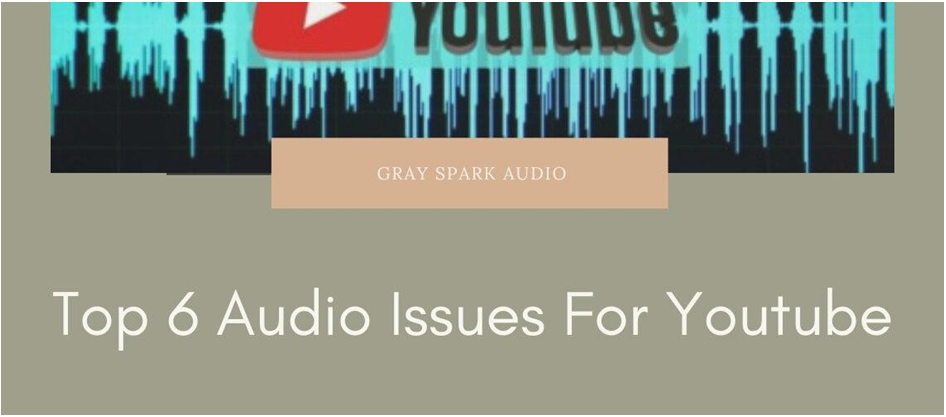Learn how to identify and fix these common sound issues to improve the quality of your YouTube videos and how we do it at our sound engineering academy in India.
As a creator, you already have all the checklists for creating great videos: Engaging content? Check.
Catchy Visuals? check.
Crisp Audio? …and if you hesitated for a moment, you are not alone. However, you shouldn’t consider audio an afterthought in your YouTube workflow. There are some troubleshooting tips that can help improve your audio. (Top 6 Audio Issues for Youtube Videos)
1. Clicks and Pops
Some call it a click, some call it a pop. Either way, this is an audio issue you definitely want to avoid in your videos. To be clear, when we talk about “clicks” and “pops”, we’re not talking about artifacts picked up by the microphone during the recording process and baked into the audio recording. I’m referring to the clicks you hear in an edit as the playhead moves over it.
It’s something you can’t ignore once you get used to the sound. When I edit a clip on the timeline and play the video, I hear the audio at the edit point between the two segments.
Solution:
Use a short crossfade transition between the two cuts. If you have stray clicks, just add transitions to individual cuts. If you have a heavily edited video with a lot of clicks, select all the edit points and add transitions to all of them at the same time. If your clip has silence at the beginning or end, you can manually add keyframes and add fades for more control.
2. Clipped and Distortion
Are the recorded audio levels too loud? If so, you now have to deal with the distortion. It looks silly. Even if you choose a completely casual and relaxed vlog-style video, distorted audio is a distracting experience for your viewers and best avoided in the first place.Cropped audio is surprisingly common in YouTube videos. But that doesn’t have to be the case. With a little preparation, distortion can be completely avoided.
Solution:
Consider two scenarios. First, there is a dedicated individual on the team. In this case, they are responsible for monitoring the audio during filming, so there is no problem. However, if you know there’s going to be a sudden loud noise in your video (like someone yelling), let them know you’re ready so they can monitor accordingly.
Other scenarios record their own video and no one monitors the audio. In this case, it is important to set the audio levels correctly. Before you shoot, you should make sure your audio levels are set correctly. A good rule of thumb is to keep levels between -10dB and -12dB, peak around -6dB, and avoid 0dB at all costs. (Top 6 Audio Issues for Youtube Videos)
3. Inconsistent Volume Level
Watching YouTube videos with uneven audio levels can be very frustrating as viewers have to turn the volume up and down to fully understand what is being said. This sound issue is a distraction and may be so annoying for some that clicking away from the video and switching to something else.Luckily, this is not a hard problem to solve.
Solution:
After locking the edit, play everything. Ignore the visuals and focus only on the audio. Then adjust the gain for each clip to ensure consistency throughout the video. It may seem like a no-brainer, but it’s actually as simple as turning down the louder parts and increasing the quieter parts. If you followed the previous point and set your levels correctly when recording, you’re off to a really good start! Once you’ve equalized the gain on all your clips, listen to the video while you edit it to hear some parts. See if you can hear the video comfortably without straining or avoiding very loud bursts of audio. It will help you get a good average level. You can further enhance your audio by adding compression or volume automation later in your mix. (Top 6 Audio Issues for Youtube Videos)
4. Unbalance and Unmixed Dialogues, Music and SFX
This is related to the previous point, and this problem can arise in two ways. The first is when the video switches between the dialogue and the music, with the dialogue being too small and the music too loud. The second manifestation of this problem is when you have dialogue on a piece of music but it is not mixed properly and overwhelms parts of the speech. The effect is the same: a video is confusing and doesn’t provide a good experience for the viewer.
Solution:
Just as the level of dialogue needs to be adjusted for consistency, you need to make sure you listen to the entire audio clip and adjust the music and dialogue for consistency. If your video has a musical background, you can avoid the music below the dialogue by using sidechain compression. Adjust attack and release to ensure smooth transitions. A multi-band compressor works well for this and provides the most natural transitions since you don’t significantly reduce the volume of the track. You create space in music for dialogue by targeting competing frequencies. So when the music fades into the background, the mix seems less empty.
5. Off-axis Coloring
Did you know when you are watching a video and the subject turns their head to the side while speaking, and suddenly there is a decrease in the level of the dialogue? This is because the sound source moves away from the main axis of the mic. This causes the sound quality to
change because the microphone’s frequency response changes as the sound moves off-axis. Off-axis color itself is not a bad thing, and it can be used to shape recorded sound in a controlled setting. In particular, what we are talking about here is when the dialogue becomes confusing because the subject turns his head away and the microphone is not picked up well.
Solution:
You can try mixing the EQ to make the sound match the rest of the dialogue, but to be honest, especially if you are working with a tight schedule, you will easily avoid this problem than fix it by mail. Choosing the right mic is the first step. Omnidirectional lavalier microphones are very popular for interviews. It picks up sound equally from all directions, which is fine if you’re in a quiet place, but not so much if you’re in a noisy environment. If your subject is being selected with a one-way scanner, make sure it’s as centered as possible. You want it to point towards the speaker’s mouth. Too far to the left or right and you risk disconnecting from the microphone, especially if they’re moving around. If you’re using an in-camera microphone, aim the microphone as close to your subject as possible, even if you’re tracking them, so that the microphone is always within the microphone’s detection range. (Top 6 Audio Issues for Youtube Videos)
6. Underestimating the Power of Sound Effects and Sound Designing
This is more of a creative issue than a technical one. A good edit with a well-shot B-roll will feel imperfect if you don’t use sound effects to highlight key moments in the edit, like camera movement, revealed. product and change the light. For a great example of how to do this well, check out Youtuber Daniel Schiffer’s product videos. He analyzes every step of the production process in detail, with a particular focus on sound design. When you watch videos with sound effects, you realize how empty the sound is without them.
Solution:
Make sound effects and sound design an integral part of your video post-production workflow. Choosing the right sound, at the right time, and combining effects to create something unique can take longer than expected, so make sure to spend more time making the SFX pass. target. Just like music, be sure to use licensed sound effects. Software like SoundQ gives you access to royalty-free, high-quality sound effects (and music), plus the ability to organize your library and send files directly to the timeline of yours to create a super-fast workflow. Would be better if you could join a sound production courses where you can learn about the science and art on how to do this the right way.
Final Lesson
No matter what stage you’re at in your YouTube journey, adopting the right best practices is critical to growing your channel. Even if you don’t have a large team and a dedicated audio staff on board, you can arm yourself with the knowledge to tackle these problems and prevent them from occurring by choosing the right microphone, learning basic techniques of audio editing and mixing and place importance on the audio portion of a video as well as on the visual elements themselves.
Ps. Also you need to know how youtube streams its audio for poor network connectivity the audio quality is low and highly compressed for high quality audio your viewer needs to have a high speed network (Top 6 Audio Issues for Youtube Videos). If you’re finding it hard to
understand how to correctly level your Dialogues and SFX it might be a good idea to consider going to a “Sound Engineering course” that can give you structured knowledge of these concepts and make it easier for you to increase your skill level. You can find a list of good “Sound Engineering Courses in Pune” here.






More Stories
The Benefits of Using YouTube to MP3
5 tips for powerful bass
Voice Acting Exercises for Beginner Voice-over Talent